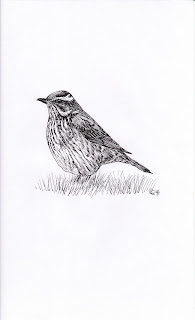The flash contained four Wigeon, 44 Teal, nine Snipe, and 174 Lapwings. Elsewhere we reached totals of 100 Linnets, 130 Chaffinches, two Bramblings, and a distant flock of at least 200 thrushes, mainly Fieldfares.
I have finally resolved my map-making problems, although I haven't worked out how to show the map on the blog without all the free map tools blurb. This gives the general idea of the size and shape of the area I cover though.
As its the end of the year I feel I should do some kind of round up, and indeed provide a full list of the birds seen in 2012. So here goes:
A total of 121 bird species were recorded on the patch as far as I know (plus Feral Pigeon if you like). I saw 117 of these, my highlights being a Corn Bunting on Jan 28, an Iceland Gull over on Feb 18, a Great White Egret over on Mar 25, a Spotted Redshank on Mar 28, a drake Garganey on Jun 7, a Black-tailed Godwit on Jul 7, a Grasshopper Warbler on Aug 5, and up to two Wood Sandpipers for a fortnight from Aug 15.
The birds I missed were a Red Kite (DJScanlan), two Oystercatchers and a Pink-footed Goose (JJYardley) and a Crossbill (MWillmott).
My full list was:
1.Mute Swan, 2. Greylag Goose, 3.Canada Goose, 4. Shelduck, 5. Wigeon, 6. Teal, 7. Mallard, 8. Pintail, 9. Garganey, 10. Shoveler, 11. Tufted Duck, 12. Red-legged Partridge, 13. Grey Partridge, 14. Pheasant, 15. Little Grebe, 16. Cormorant, 17. Little Egret, 18.Great White Egret, 19. Grey Heron, 20. Sparrowhawk, 21. Buzzard, 22. Kestrel, 23. Merlin, 24. Hobby, 25. Peregrine, 26. Moorhen, 27. Coot, 28. Little Ringed Plover, 29. Golden Plover, 30. Lapwing, 31. Dunlin, 32. Ruff, 33. Jack Snipe, 34. Common Snipe, 35. Curlew, 36. Black-tailed Godwit, 37. Common Sandpiper, 38. Green Sandpiper, 39. Wood Sandpiper, 40. Redshank, 41. Spotted Redshank, 42. Greenshank, 43. Black-headed Gull, 44. Common Gull, 45. Lesser Black-backed Gull, 46 Herring Gull, 47. Iceland Gull, 48. Great Black-backed Gull, 49. Stock Dove, 50. Woodpigeon, 51. Collared Dove, 52. Cuckoo, 53. Barn Owl, 54. Little Owl, 55. Tawny Owl, 56. Swift, 57. Kingfisher, 58. Green Woodpecker, 59. Great Spotted Woodpecker, 60. Skylark, 61. Sand Martin, 62. Swallow, 63. House Martin, 64. Tree Pipit, 65. Meadow Pipit, 66. Yellow Wagtail, 67. Grey Wagtail, 68. Pied Wagtail (and White Wagtail), 69. Wren, 70 Dunnock, 71. Robin, 72. Redstart, 73. Whinchat, 74. Stonechat, 75. Wheatear (and probably Greenland Wheatear), 76. Blackbird, 77. Fieldfare, 78. Song Thrush, 79. Redwing, 80. Mistle Thrush, 81. Grasshopper Warbler, 82. Sedge Warbler, 83. Reed Warbler, 84. Blackcap, 85. Lesser Whitethroat, 86 Common Whitethroat, 87. Chiffchaff, 88. Willow Warbler, 89. Goldcrest, 90. Spotted Flycatcher, 91. Long-tailed Tit, 92. Blue Tit, 93. Great Tit, 94. Coal Tit, 95. Marsh Tit, 96. Nuthatch, 97. Treecreeper, 98. Jay, 99. Magpie, 100. Jackdaw, 101. Rook, 102. Cattion Crow, 103. Raven, 104. Starling, 105. House Sparrow, 106. Tree Sparrow, 107. Chaffinch, 108. Brambling, 109. Greenfinch, 110. Linnet, 111. Goldfinch, 112. Siskin, 113. Lesser Redpoll, 114. Bullfinch, 115. Yellowhammer, 116. Reed Bunting, 117. Corn Bunting.
I am now looking forward to next year, which for me may start on January 5, but I may get a chance to have a quick look on New Year's day.


































